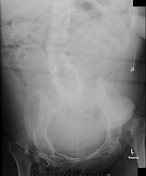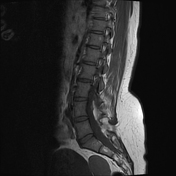115 results found
Article
Butterfly vertebra
Butterfly vertebra, also sometimes known as a sagittal cleft vertebra or anterior rachischisis, is a type of vertebral anomaly that results from the failure of fusion of the lateral halves of the vertebral body because of persistent notochordal tissue between them.
Pathology
Butterfly vertebra...
Article
Diastematomyelia
Diastematomyelia, also known as a split cord malformation, refers to a type of spinal dysraphism (spina bifida occulta) characterised by a longitudinal split in the spinal cord.
Terminology
Although traditionally, it has been distinguished from diplomyelia (in which the cord is duplicated rat...
Article
Scoliosis
Scoliosis (plural: scolioses) is defined as an abnormal lateral curvature of the spine. It is quite common in young individuals and is often idiopathic and asymptomatic. In some cases, however, it is the result of underlying structural or neurological abnormalities.
Terminology
Early onset sco...
Case
Sprengel deformity

Published
29 Jan 2024
92% complete
CT
Article
Conjoined nerve root
Conjoined nerve roots are the most common nerve root developmental anomaly of the cauda equina, being twice as common as two roots in the same foramen, the next most common anomaly.
Epidemiology
The incidence in cadaveric studies is ~10% (range 8-14%) 2, and in one prospective MRI study was 6%...
Article
Craniorachischisis
Craniorachischisis, also known as craniorachischisis totalis, is a rare birth defect and the most severe of the neural tube defects. It refers to the presence of both anencephaly and spina bifida.
Epidemiology
In one study the prevalence of craniorachischisis was 0.51 per 10,000 live births in...
Article
Chiari II malformation
Chiari II malformations are relatively common congenital malformations of the spine and posterior fossa characterised by myelomeningocele (lumbosacral spina bifida aperta) and a small posterior fossa with descent of the brainstem, cerebellar tonsils, and vermis through the foramen magnum. Numero...
Case
Unfused and incompletedly fused thoracic spinous processes

Published
06 Feb 2021
92% complete
CT
Article
Charcot joint
Charcot joint, also known as a neuropathic joint or Charcot (neuro/osteo)arthropathy, refers to a progressive degenerative/destructive joint disorder in patients with abnormal pain sensation and proprioception.
Epidemiology
In modern Western societies by far the most common cause of Charcot jo...
Article
Congenital diaphragmatic hernia
Congenital diaphragmatic herniation (CDH) accounts for a small proportion of all diaphragmatic herniae. However, it is one of the most common non-cardiac fetal intrathoracic anomalies.
Epidemiology
Congenital diaphragmatic hernias are seen in 1 of every 2000-4000 live births. 84% are left-side...
Case
Hip dislocation and spina bifida

Published
21 Mar 2018
91% complete
X-ray
Article
Pes cavus
Pes cavus, also known as talipes cavus, refers to a descriptive term for a type of foot deformity with an abnormally high longitudinal arch of the foot (caved-in foot).
Epidemiology
Associations
It is often associated with certain neuromuscular disorders such as:
Charcot-Marie-Tooth disease:...
Article
Neural tube defects
Neural tube defect (NTD) refers to the incomplete closure of the neural tube in very early pregnancy, resulting in cranial defects or spinal dysraphism.
The neural tube comprises a bundle of nerve sheath which closes to form brain caudally and spinal cord rostrally. The closure should occur at ...
Article
Tethered cord syndrome
Tethered cord syndrome is a neurological disorder caused by tissue attachments that limit the movement of the spinal cord within the spinal canal.
Clinical presentation
Tethered cord syndrome is a clinical diagnosis based on neurologic deterioration involving the lower spinal cord 7. Patients ...
Article
Spinal dysraphism
Spinal dysraphisms refer to a broad group of malformations affecting the spine and/or surrounding structures in the dorsum of the embryo. They are a form of neural tube defect.
Pathology
The neural tube is formed by the lengthwise closure of the neural plate, in the dorsum of the embryo.
The ...
Case
Bertolotti syndrome

Published
08 Feb 2024
94% complete
X-ray
Case
Diastematomyelia

Published
09 Sep 2022
95% complete
MRI
Case
Myelomeningocele

Published
30 Aug 2023
95% complete
MRI
Case
Spina bifida with tethered cord and lipomyelocele

Published
11 Jan 2024
95% complete
MRI
Article
Klippel-Feil syndrome
Klippel-Feil syndrome is a complex heterogeneous entity that results in cervical vertebral fusion. Two or more non-segmented cervical vertebrae are usually sufficient for diagnosis.
Epidemiology
There is a recognised female predilection 1. Klippel-Feil syndrome has an incidence of 1:40,000-42,...









 Unable to process the form. Check for errors and try again.
Unable to process the form. Check for errors and try again.